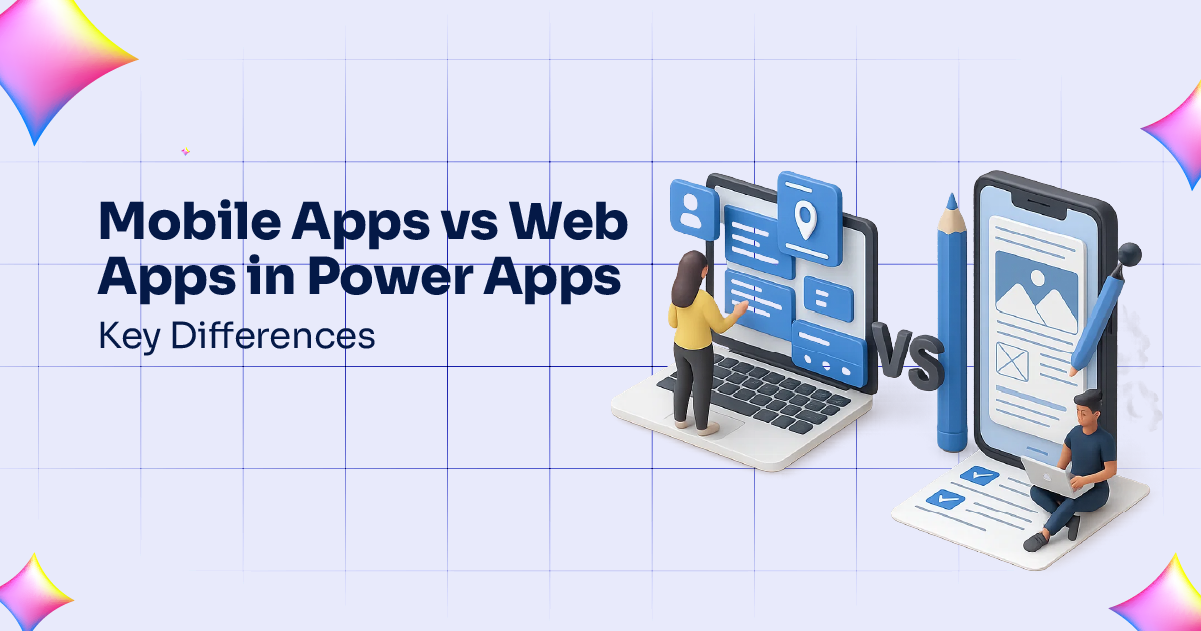
In today’s fast-paced digital landscape, businesses demand agile, scalable, and efficient applications to streamline operations and improve user engagement. Microsoft Power Apps has emerged as a game-changer in low-code development, enabling both technical and non-technical users to build custom business applications rapidly. Whether you’re developing a mobile app or a web app, Power Apps offers a unified platform—but choosing the right type of app depends on your goals, audience, and functionality.
In this blog, we will explore the key differences between building mobile apps and web apps using Microsoft Power Apps, helping you decide which is best suited for your business needs.
Understanding Microsoft Power Apps
Microsoft Power Apps is a suite within the Microsoft Power Platform that allows users to create custom apps without extensive coding knowledge. These apps can connect to a variety of data sources, including SharePoint, Excel, SQL Server, and cloud services like Microsoft Dataverse. Power Apps supports two primary app types:
- Canvas Apps – Highly customizable, drag-and-drop style apps designed for specific use cases.
- Model-driven Apps – More data-centric, built around your business data and processes.
These apps can be accessed via the web, mobile devices (iOS/Android), or embedded within Microsoft Teams and SharePoint.
What Are Web Apps in Power Apps?
Web apps built with Power Apps are designed to run in a browser. They offer broad accessibility across devices without the need for downloads or installations. Users simply visit a URL to access the app. These are ideal for business users working in office environments where desktops or laptops are the primary tools.
Key Features of Web Apps:
- Optimized for desktop browsers
- Easy access via URL
- Seamless integration with other Microsoft 365 tools
- Ideal for data-intensive tasks
- Typically better for complex UI layouts
What Are Mobile Apps in Power Apps?
Mobile apps, on the other hand, are designed specifically for mobile devices. These can be accessed through the Power Apps mobile application available on iOS and Android. While users still need to log in via the app, mobile apps can utilize native device capabilities such as the camera, GPS, and touch gestures, offering a richer, more responsive experience on the go.
Key Features of Mobile Apps:
- Optimized for touch-based interaction
- Access to native mobile device features (e.g., camera, GPS, push notifications)
- Offline capabilities for limited functionality without internet
- Lightweight, fast-loading for quick tasks
- Best for field operations or remote workforces
Key Differences: Mobile Apps vs Web Apps with Power Apps
1. User Experience and Interface
- Mobile Apps: Built with mobile-first design, offering a compact and touch-friendly user interface. Best suited for apps where quick interactions are needed, like inventory scanning or on-site inspections.
- Web Apps: Designed with broader screen real estate in mind, supporting complex layouts and workflows. These apps are ideal for dashboard viewing, form processing, and report generation.
2. Accessibility
- Web Apps: Accessible through any modern browser on desktops and laptops. No installation required.
- Mobile Apps: Require the Power Apps mobile application. Though slightly less convenient to access initially, they provide a superior mobile experience.
3. Offline Functionality
- Mobile Apps: Can be designed to work offline, syncing data once the device reconnects to the internet—critical for field workers in remote locations.
- Web Apps: Require constant internet connectivity. Not suitable for offline use.
4. Device Capabilities
- Mobile Apps: Support native device features like camera, barcode scanner, microphone, and GPS—enhancing app utility in real-world scenarios.
- Web Apps: Have limited access to hardware features, depending on browser support and security permissions.
5. Performance
- Mobile Apps: Generally more responsive for quick, task-oriented usage but may have limited functionality due to screen size or simplified design.
- Web Apps: Can handle more data, larger forms, and complex navigation more efficiently.
6. Development and Maintenance
- Both app types can be developed using the same Power Apps interface. However:
- Mobile apps require more attention to responsive design and touch interactions.
- Web apps need to be tested across different browsers for compatibility.
Power Apps offers reusable components and cross-platform capabilities, reducing the time and cost of maintaining separate codebases.
Use Case Scenarios
Mobile App Use Cases:
- Field service operations
- Inventory scanning
- On-site audits or inspections
- Employee attendance tracking with GPS
Web App Use Cases:
- HR portals
- Finance and accounting dashboards
- Procurement forms and approval systems
- Data analysis and reporting tools
Final Thoughts: Which One Should You Choose?
Choosing between a mobile or web app depends on your business goals, target users, and how the app will be used. If you’re looking to empower on-the-go employees and use mobile hardware features, mobile apps are your best bet. On the other hand, if your team relies heavily on data entry, dashboards, and desktop workflows, web apps provide a more robust environment.
The good news? With Power Apps, you don’t necessarily have to choose just one. Apps developed on the platform are often responsive and can work across devices, giving you the flexibility to serve a wider audience.
Whether you’re building for mobile or the web, Microsoft Power Apps offers the agility, speed, and power to transform your business processes.
